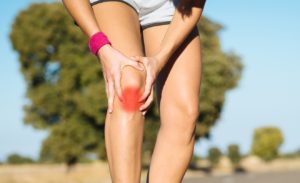Patellar Tendonitis

Patellar tendonitis, or jumper’s knee, is pain just below the knee in a band of tissue that connects the knee cap, the patella, to the shin bone, the tibia.
What causes patellar tendonitis?
Patellar tendonitis is an overuse injury caused by repeated flexing and extension of the knee. This repetitive movement creates excessive strain in the patellar tendon which leads to inflammation and pain. The most common activity causing patellar tendonitis is jumping or plyometrics. For most athletes, this occurs during cross-training. Other activities involving repetition in knee movement can also cause patellar tendonitis. Running, walking, and bicycling are know causes as well. In essence, any activity that puts repeated stress on the patellar tendon can cause inflammation of the tissue.
How is patellar tendonitis diagnosed?
Clinical examination and patient history are typically sufficient to make the diagnosis of patellar tendonitis. Generally, pain just below the knee cap is present. Inflammation and swelling are sometimes present as well. Patients typically describe pain with jumping, running, walking up and down stairs, and bending of the knee. X-rays and an MRI are sometimes used to assist in the diagnosis and to rule out other potential problems such as: arthritis, bone spurs, meniscal injuries, ligament injuries, and bursitis. For a runner, examination of your running biomechanics is key to a proper diagnosis. A 3D gait examination will provide detailed insight into the movement patterns that contribute to patellar tendonitis.
How is patellar tendonitis treated?
Treatment for patellar tendonitis focuses on two main problems: inflammation and biomechanics. Inflammation is best treated with ice, non-steroidal anti-inflammatory drugs (NSAIDs) and rest. A band called an infra-patellar strap or even a knee brace can reduce strain in the tendon. Biomechanical deficiencies are treated with strengthening and stretching exercises along with physical therapy. Foot orthotics have been show to effectively improve pain in some patients. Rarely, but sometimes, surgery is necessary to treat inflammation and damage within the tendon.
When can I return to running?
The goal of rehabilitation is return you to running as soon as is safely possible. If you return to a full training load too soon, the injury may return or worsen. Everyone recovers from injury at a different rate, so don’t compare your rehabilitation to other runners. Returning to running is determined by how well your knee responds to treatment rather than a set number of days or weeks. In general, the longer you have had the symptoms, the longer it will take you to recover. Here are some general guidelines for a full return to running. Keep in mind, some runners may not have to completely stop running, but merely reduce their training load (distance, intensity, frequency) during the rehabilitation process.
- You should be able to bend and straighten your knee without pain.
- Your knee should not be swollen.
- You should be able to jog in a straight line without limping.
- You should be able to sprint without limping.
- You should be able to perform 45-degree and 90-degree cuts without difficulty.
- You should be able to jump on both legs without pain.
- You should able to jump on the injured leg without pain.
What can be done to reduce the chances of developing patellar tendonitis?
The most important factor in preventing patellar tendonitis involves addressing the root causes. So what are the root causes? It is generally accepted that more than half of all running injuries involve errors in training. This could include total mileage, running intensity, increasing the intensity and mileage too quickly, and finally the physical terrain (hills, trails, etc.). Improving areas of biomechanical deficiency also is important. This involves consistent focus on strength and flexibility of the hips and legs.
This information is not intended to diagnose, treat, or prevent any injury or disease. It is intended serve as an overview of running-related injuries and should not be used as a substitute for sound medical advice from a doctor or therapist.


